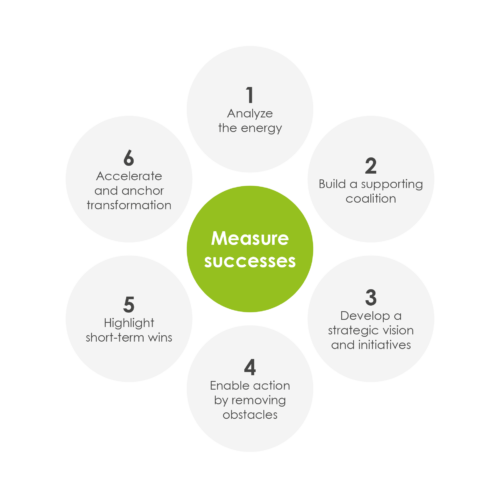How can an organisation be developed in an agile way? Based on John Kotter's change model, we have developed a simplified form of intervention that can be summarised in six phases:

Agile organisational development
What can you do to make your organisation agile? If you follow the following 6 steps, there is a high probability that they will turn the people involved into stakeholders.
First of all, it must be clear to everyone involved why the organisation needs to change, why this is necessary right now and what the benefits will be for the people. There are different ways in which this origin energy can arise:
It is not always about creating new energy. It is often already there – but it is not visible enough. In our experience, it is crucial to start transformation processes where the energy is already high – in other words, to proceed in a resource-oriented way. If you want to measure this, you can use the Transformation Check at the organisational level.
Ambassadors are needed to drive the change. In this phase, a group of people is put together to effectively accompany the change within the company.
This coalition provides a shared vision for change. The energy created in phase 1 only makes it clear that the organisation has to move. But it still leaves open where to go. Phase 3 gives direction and fills the energy with life. It is important to have an outlook on what the employees can expect. At ProMove TM we always develop ideas at this point about what employees can get rid of, so that there is room for strategic visions and initiatives in the first place (see also phase 4). The 20 tics that prevent managers from using their full potential can be helpful at this point.
There is no moving forward without friction. Most transformation projects idealise their system's competence in dealing with resistance. Ideally, barriers to transformation were removed earlier in the process. However, experience shows that this has hardly ever been done stringently. The company probably still has structures that make change considerably more difficult, if not impossible. Now is the time to remove these as far as possible, otherwise the "supporting coalition" will become disillusioned and probably little will change.
At least as important as the removal of structural barriers in this phase is helping people to overcome their inner resistance to change. Experience shows that change fails for four main reasons:
A very effective way to work on the four resistances is to let the people involved write transformation stories themselves. What does the change mean to them? What does it bring them? What resistances do they have to overcome and how do they overcome them? How would you describe their behaviour in the process? A personal “heroic epic“, gives people the chance to find their individual path for transformation.
Change work is exhausting and often has to be done in addition to existing work. For this reason, we at ProMove TM develop concrete ideas early on in transformation processes about what employees can say goodbye to (see also phase 3). In any case, it is helpful to quickly make successes visible. In this way, employees who carry out change work can feel their own effectiveness. At least some sceptics will be convinced by real successes. The project sponsor will also be satisfied if he can show successes. Without short-term successes, there is a danger that change projects will quickly fall asleep again.
This last step is about sustaining the energy for change. This phase, in contrast to phase 5, is about “long term wins”. Change never stops. After the project is before the project. New structures are not meant to be set in stone. They are only the prelude to further improvements. At this point, it is about anchoring the momentum and creating a lasting culture of change.
It seems important to us in all steps that we measure and communicate progress regularly. There are no limits to creativity here. Whether you climb to the top with a virtual cable car, or place plexiglass columns at the reception in which the employees throw coloured balls according to their perception: the decisive factor is that the transformation is made visible.